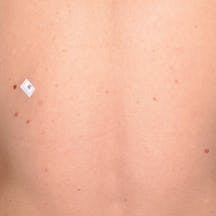
It is not really a game. It is dead serious.
By definition (a contest played according to rules) it is a game, because it is a contest and there are rules.
The contest
Educate. Inspire. Save lives. NFTsavesliv.es
Melanoma Snail Game
Learn. Enter. Win.
The first person (1) learning about melanoma from the Melanoma Snail Collection NFTs (2) getting suspicious about a mole on his/her skin or skin of a loved one or a friend (3) getting it checked by a doctor, who confirms the suspicion, so (4) the lesion gets removed and (5) the histology verifies the diagnosis, finally (6) they letting me know about this.
The rules
#1. During the doctor's visit it should be stated and recorded that the knowledge and skills to recognise a suspicious skin lesion is gained by studying the Melanoma Snail Collection NFTs. This evidence is needed in order to win the game.
#2. The histology analysis following the removal of the suspicious skin lesion must confirm the initial clinical diagnosis of melanoma.
#3. It also counts if the doctor finds another lesion during the visit which proves to be a verified melanoma.
#4. The first person who sends Dr Bela the medical record of the initial visit containing the statement defined in point #1 and the histology report verifying the melanoma diagnosis according to point #2 wins the game.
#5. These documents should be sent to info@melanomasnail.com
#6. The winner will be determined by the date and time of the email(s) with all necessary proofs defined in point #1 and #2 arrive.
#7. The winner will be announced on the official website and via all other communication channels. The winners will be contacted directly as well.
#8 A second and third place will be announced based on point #6.
#1 This is not the aim of the Melanoma Snail Game to flood medical practices with unnecessary claims.
Please, study the examples below what skin lesion is potentially suspicious and what is not. It is really difficult sometimes to diagnose a melanoma even with long years of experience, so it is even more difficult to explain to a lay-person what is suspicious and what is not. If you have a suspicion about a skin lesion at the end of the day, have it checked.
It is confirmed in epidemiological studies again and again the early diagnosis of melanoma saves lives.
#2 Never ever try to diagnose a skin lesion yourself and absolutely don't use any home-kit for mole removals widely advertised on the internet.
It is difficult to diagnose a melanoma, and if you happen to remove one for yourself, it will have a very sad conclusion.
Pigmented skin lesions MUST NOT be removed with laser, cryotherapy, cauterisation, or by the means of any erosive agents - even if a doctor recommends it - when HISTOPATHOLOGY analysis of the lesion is not possible.
Warnings/suggestions
The prizes (1st, 2nd and 3rd)
#1 The biggest win of the winners is their life. Early diagnosis and removal of a melanoma saves lives. This is the very purpose and mission of the Melanoma Snail NFT Collection.
#2 The winner takes NFT #100 from Phase 1 created by Dr Bela.
#3 The winner takes an NFT from Phase 2 created by one of the co-creator artists/celebrities (yet to be decided which one).
#4 The 2nd and 3rd place winners will take one-one NFTs from phase 2 (yet to be decided which one)
#3 All winners can have 2 moles checked by Dr Bela each year free of charge for 5 years (telemedical analysis)*.
#1 After studying the Melanoma Snail NFT Collection, now you understand how melanoma develops, how it looks on the skin and the potential consequences of late diagnosis.
#2 Different people have different risk for melanoma. The following factors increase one's personal risk: (1) fair skin type (2) the number of moles - the higher the number, the higher the risk - (3) family history of melanoma, (4) history of blistering sunburn. The lack of any of these, doesn't mean that one cannot have a melanoma.
#3 People with darker skin can have melanoma only on their palms, soles or nails. Bob Marley died of melanoma originated on his foot.
#4 The whole body surface should be checked (see point #3 as well). Melanoma can appear at any part of the body, not only at sun exposed locations.
#5 Look for the ugly duckling lesions, ones that look different from the rest.
How to find suspicious lesions?




#6 Look for asymmetrical moles, like the ones on the pictures above.
#7 It doesn't matter whether the lesion is completely flat or elevated.
#8 Look for skin lesions that might be new or changing, although it can be misleading: sometimes patients state that an obvious melanoma is unchanged for a long time. It is due to the very slow pace of progression, that makes it difficult to detect. Hence the snail analogy.


* For medicolegal reasons these tele-medical mole checks should go through an official route where personal details and medical history is taken and the pictures of moles are made by special instructions from Dr Bela.
It depends on the country where you live.
In the UK and Hungary - the healthcare systems that I know - you can go to your GP - although they are a bit hesitant to check moles and it is not within their experties most of the times - or there are private providers too. Search for providers on Google, but bear it in mind, that the diagnosis of melanoma can be challenging and experience of individual doctors varies.
I run a limited online mole check service for my patients, but since I work full time I cannot manage high numbers and it is a time consuming process. Fees and T&Cs apply.
Where do you have your moles checked?

